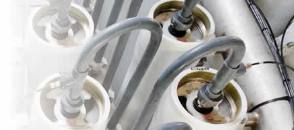Membranes and Membrane Fouling
The INPHAZE Impedance Spectrometer is able to measure the phase angle at each frequency with unprecedented precision. This enables it to:
- Resolve separately the dielectric properties of the substructural layers within the membrane and layers formed on the surface of a membrane, such as diffusion polarization and cake layers.
- Determine in situ the changes that occur to these properties with membrane fouling during operation using on-line data reduction methods.
When two such layers are juxtaposed the capacitance and conductance of the combination will vary with frequency in a manner that reflects the properties of the component structure.
With the high resolution INPHAZE spectrometer and analytical software it is possible to deduce the parameters for the individual layers from measurements of the capacitance and conductance of a membrane over a wide frequency range.
When membrane fouling occurs, the dielectric parameters are changed. These changes can be readily determined using impedance spectroscopy measurements during actual membrane operation.
Membrane Structure
A cross-sectional electron micrograph of a micro porous filtration membrane. The membrane has two distinct substructural layers: skin and sub layer.
The equivalent circuit for a membrane containing two such substructural layers in contact with an aqueous electrolyte.
Membrane Fouling
When membrane fouling occurs, the dielectric parameters are changed. These changes can be readily determined using impedance spectroscopy measurements during actual membrane operation.
Reverse Osmosis (RO) Membrane Fouling
The impedance spectra for the fouled and unfouled membrane reveal the presence of three distinct elements; the skin layer, the membrane sub layer and a diffusion polarization/fouling layer.
Illustrated here is Impedance vs Frequency for a fouled and unfouled RO membrane. Fouling is attributed to a decrease in the conductance scaling factor in the diffusion polarization layer (alpha). The foulant in this case is CaCO3.
The data reduction shows that the basic membrane elements (skin layer and sub layer) did not change onfouling. This is to be expected as there are no pores in an RO membrane. However, the fouling produced a very distinct change in the parameters describing the interfacial polarization layer. The formation of the foulant layer on the surface produces significant changes in the membrane solution interface where diffusion polarization occurs.
Membrane fouling can therefore be simply described in terms of the conductance scaling factor for the interfacial polarisation layer. Reduction of this data in terms of the basic dielectric parameters provides an insight into the state of fouling of the membrane.
Nanofiltration (NF) Membranes
Fouling as detected by the INPHASE spectrometer in NF membranes leads to changes in the skin layer and sub layer in addition to the diffusion polarization layer. This is to be expected as there are distinct pores in an NF membrane.
Interfacial polarization conductance scaling factor for an unfouled and foulded RO membrane.
| download the PDF application note |
|




